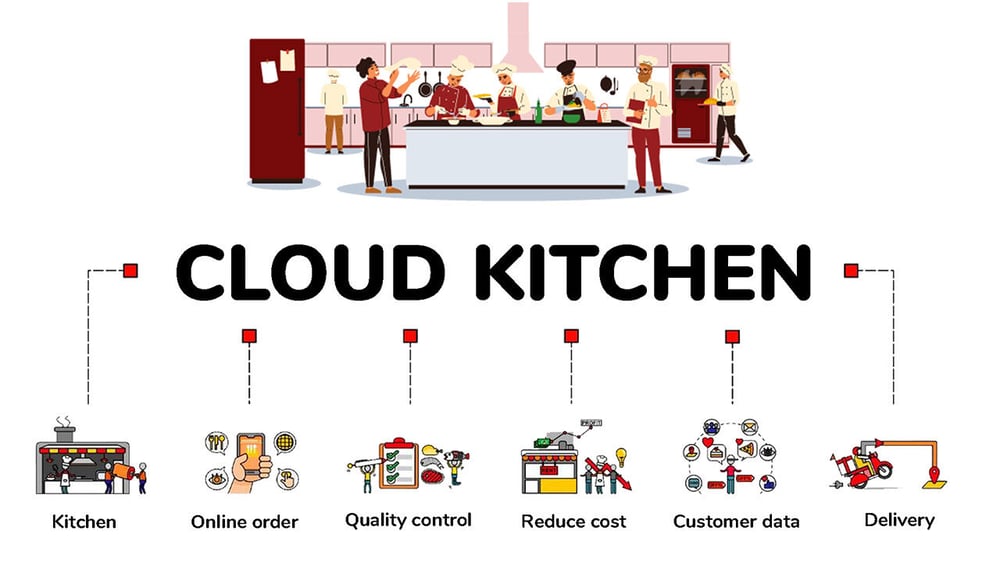
During the past few years, there has been a big change in the food industry and one idea is becoming very popular quickly: cloud kitchen. These setups are also called ghost kitchens, virtual kitchens or dark kitchens. They are changing our perspective on dining and how we get food delivered to us.
What makes this concept so attractive?

Table of Contents
- Definition of a Cloud Kitchen
- How Cloud Kitchens Operate
- Benefits of Cloud Kitchens
- Challenges and Considerations
- Types of Cloud Kitchens
- Technology and Tools for Cloud Kitchens
- Case Studies and Examples
- Future of Cloud Kitchens
- Call to Action
It is not complex, cloud kitchens provide an adaptable and economically efficient answer to handle the increasing requirement for delivering food online. This blog will explore what cloud kitchens are, how they function, their advantages and difficulties, as well as what might come next for them.
Cloud kitchen vs traditional restaurant is not a very difficult concept to understand as keep on reading to know more!
Are you ready to dive into action?
Definition of a Cloud Kitchen
Cloud Kitchen, what is it basically?
Fundamentally, a cloud kitchen represents a commercial kitchen made specifically for food delivery. Different from usual restaurants where they give food to customers at their place, cloud kitchens are only concerned with making ready food that will be delivered or taken away. The virtual kitchen concept has made starting with less budget very easy for the people wanting to start up.
The term "cloud kitchen" might sound complicated or confusing. To put it simply, a cloud kitchen is a restaurant without any dining area for people to eat inside the establishment.
The main focus is on preparing and cooking meals for delivery services or takeout options instead of serving customers directly in-house like what traditional eateries usually do. They do not have dining rooms, waitstaff, and many times no storefront.
They usually work in industrial spaces that can hold more than one brand inside them. This helps businesses concentrate on cooking and sending out good food without paying extra for regular restaurant activities.
How Cloud Kitchens Operate
 One question people often wonder about is how do cloud kitchens work. Let us get to it!
One question people often wonder about is how do cloud kitchens work. Let us get to it!
The cloud kitchen framework is very different from the usual restaurant business model. It can be seen as a centre for making food where many kinds of dishes are cooked only for delivery purposes.
The normal arrangement consists of a commercial kitchen area with all needed appliances, places to keep things and packaging stations. Ghost kitchen explanation is as simple as it seems!
In this model, technology has a key function. Ordering platforms and delivery apps like UberEats, DoorDash or Grubhub are essential parts of cloud kitchens as they help in smooth order handling and managing to send the food correctly.
Cloud kitchens usually use cloud kitchen management software and inventory tools, kitchen automation systems, as well as data analysis methods. These assist in making the work more efficient, controlling food standards, and understanding customer choices and patterns.
A cloud kitchen setup guide is all you need to step into the reign of ghost kitchens!
Benefits of Cloud Kitchens
What is the reason behind the high interest of many entrepreneurs and established brands in this cloud kitchen model? There are many advantages of a cloud kitchen business model:

Cost Savings: The big advantage of cloud kitchens is that it helps to reduce costs for rent and other overheads. If you do not need a high-quality location or front-of-house workers, this can save businesses a lot of money.
Freedom to Try New Menus: Cloud kitchens allow the flexibility for businesses to test different menu offerings. As there is no physical menu or dining experience, this gives the freedom of quickly adjusting according to changing customer choices and trends.
Larger Range of Customers: Concentrating on delivery lets cloud kitchens aim at a broader group. The limits of geography become less, enabling businesses to provide service to clients from different places without requiring multiple physical outlets.
Scalability: With cloud kitchen models, it becomes easier to grow in new places. Businesses can create kitchens in different locations more easily, making quick expansion and market entry possible. With the help of kitchen automation software, they become really easy to scale.
Challenges and Considerations
Cloud kitchens, like any business model, have their own unique problems.

Competition: The market for online food delivery is full of strong competition. To be noticed, it is necessary to have excellent quality in food, quick service and powerful branding.
Food Quality and Consistency: Making sure the food is consistently good in all locations and every time it is ordered is very important. This needs careful attention to detail and strong control of quality.
Transport and Delivery: Making sure that deliveries work well is very important for a cloud kitchen to succeed. This includes managing delivery logistics, making sure orders are delivered on time, and dealing with customer complaints.
Marketing and Brand Visibility: When there is no physical place, cloud kitchens need to put much effort in digital marketing and brand visibility. The task of gaining a steady group of customers demands good online promotion tactics as well as strong presence on social media platforms.
Types of Cloud Kitchens
Yes, Cloud Kitchens too have their types!
Various types of cloud kitchen operations are available, designed to meet different business requirements and models:
Single-Brand Cloud Kitchens: These kitchens are dedicated to one brand or idea, making it possible to concentrate operations and marketing strategies on a single unified menu.
Cloud Kitchens with Many Brands: This term refers to kitchens that hold many different brands in one place, frequently using the same cooking area and materials to increase productivity and choices.
Co-Working Cloud Kitchen Spaces: These are kitchen spaces that many businesses share. They can rent stations in these kitchens, making it a good choice for small startups and food entrepreneurs who want to reduce their first investment costs as they do not need their own space saving them a huge sum of money.
Cloud Kitchens Managed by Aggregators: Delivery aggregators such as UberEats or DoorDash take care of the kitchen spaces. They give infrastructure and logistics aid to different food labels which makes it easier for them instead of looking for spaces they can focus on growing their brand.
Technology and Tools for Cloud Kitchens
Cloud Kitchens without any tech do not make any sense. Now do they?
Technology is the foundation of a prosperous cloud kitchen operation as cloud kitchens rely a lot on technology. Vital restaurant cloud management software and instruments are as follows:

POS Systems: These systems are essential for handling orders, receiving payments, and keeping track of sales figures.
Inventory Management: Inventory management software is beneficial for keeping track of stock levels, managing suppliers and minimising food waste.
Kitchen Automation: Automation tools help make kitchen work more efficient, lessening the chances for human mistakes and ensuring uniformity. Cloud kitchen scheduling software can reduce discrepancies making it even easier to handle.
Data Analytics: It is very important to look at customer data and sales trends for wise business decisions. Restaurant analytics tools give an understanding about what customers like, how they order things and what is happening in the market.
Case Studies and Examples
Not many can make it big in the industry, but let us look at the ones who did!
Let us look at some real-life cloud kitchen examples that made it big:
Rebel Foods: This is the biggest internet restaurant company globally. Rebel Foods runs many brands such as Faasos, Behrouz Biryani and Oven Story Pizza. They excel in using data analysis, improving kitchen work and growing quickly into fresh markets and these are the names you might have even heard. They have made it this big.
Sweetgreen: Sweetgreen is a salad-focused brand that uses the cloud kitchen model to grow its business and meet the needs of health-conscious customers which is a growing industry. The company has been successful in building customer loyalty by offering fresh ingredients for their meals as well as prompt delivery services which are loved by the customers the most. Not to forget they use robots to prepare salads.
Kitchen United: This company provides shared kitchen space with all necessary infrastructures for different food businesses. The model they rely on permits restaurants to swiftly enter fresh markets and experiment with new ideas, minimising the risk involved.
Future of Cloud Kitchens
You might want to start a cloud kitchen since you have come so far, but does it really have a future?
The future of cloud kitchens looks promising, driven by several key trends and advancements as the online food delivery kitchen is one aspect of hospitality that is rapidly growing:

Technological Advancements: Improvements in kitchen automation, artificial intelligence (AI), and data analysis will further boost the functioning of cloud kitchens. This will lead to better effectiveness and contentment of customers as at the end of the day we all need happy customers.
Consumer Behaviour: In this new era of online food delivery, the increase in consumers using these services is predicted to boost the need for cloud kitchens. The main reasons behind this are convenience, variety and quality along with saving people the hassle of getting ready and physically waiting in lines to get the table if they do not have a booking.
Market Expansion: Cloud kitchens are flexible and can be quickly set up, allowing businesses to expand into new areas. This aids in the access of growing markets and satisfies increasing requirements for variety in food choices as you can offer different types of cuisines and experiment at the same time with what works for you and what does not.
Call to Action
Curious to know more about the newest things in the world of food?
Subscribe to our blog and get updated regularly. Do you have any stories or experiences with cloud kitchens? Please share your opinions and tales in the comment area. If you are thinking of starting a cloud kitchen, explore our knowledge base and assistance for starting off correctly.
Knowing all the details about cloud kitchen trends can help you understand them better, and it will prepare you to make use of the chances that this growing field provides.
If you have come this far that means you want to open a cloud kitchen, do not worry we have a help guide made for you. Read how to start a cloud kitchen.
Grasping the complexities of cloud kitchens is central to successfully manoeuvring through this changing field and taking full advantage of its possibilities becomes manageable with cloud-based kitchen software. Whether you are thinking about setting up a cloud kitchen or looking for methods to improve your current operations,
StockTake Online can provide answers. With our complete set of instruments - from our best cloud kitchen software all the way down to detailed reporting - we make certain your cloud kitchen works with ease and effectiveness.
Are you excited to witness the change in your business with our cloud kitchen inventory management software? Schedule a free live demo now, and explore the prospective future of food service through StockTake Online. Have a good time cooking!


